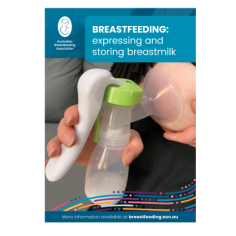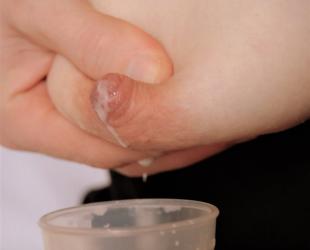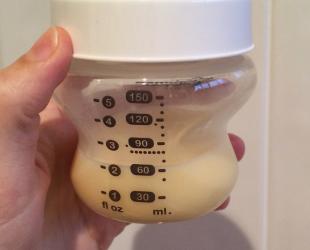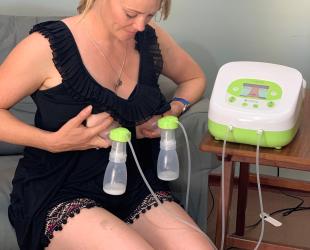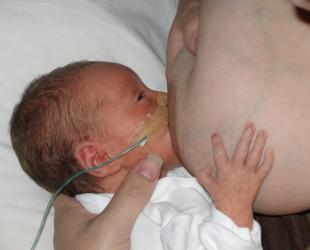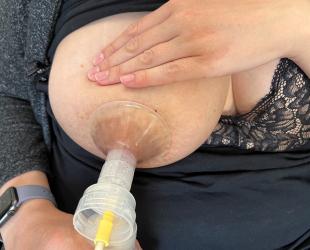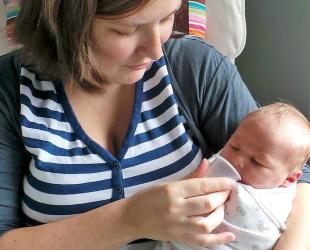If your baby isn’t feeding from your breast after birth, you will need to express

Colostrum is the first milk you will make and it’s very important, especially if your baby is premature or sick. Start expressing as soon as possible after the birth.
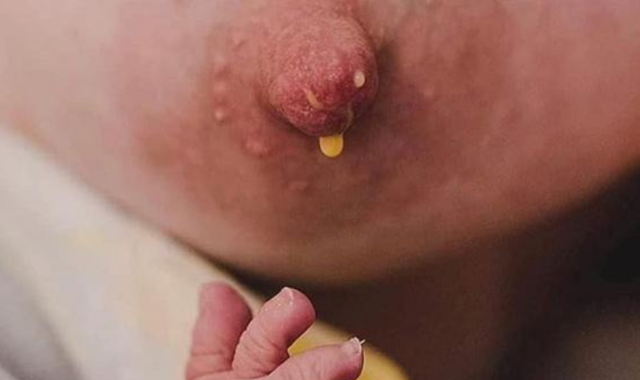
How much milk does my newborn need?
A newborn baby’s stomach only holds a tiny amount and colostrum is also only produced in small amounts. You can see by the numbers below that you may only be expressing a few drops at a time but this increases rapidly in the first week.
Healthy, term breastfed babies tend to take these amounts at each feed during the first week:1
1 day old - 2 to 10 mL
1 to 2 days old - 5 to 15 mL
2 to 3 days old - 15 to 30 mL
3 to 4 days old - 30 to 60 mL
Over the next few weeks milk supply increases, with frequent feeding of between 500 and 700ml per day by about the second week. This may sound like a lot to express, but if you start gradually and express often, the amounts you get will soon increase.
Expressing in the first week
Colostrum is thick and small in volume, so you will need to express it by hand.2 You can collect the drops of colostrum with a small syringe or teaspoon. If you are unwell after the birth, a midwife or your partner may help you express your breasts by hand.
Around 2 to 6 days after birth your milk supply will increase and you’ll notice the colour start to change from yellow to white. You’ll also notice that you can express more. At this time most mums become aware of their let-down reflex.
As your supply increases, you might find it helpful to begin using a breast pump, or combining pumping with hand expressing.3
How often should I express?
Try to express as often as you can. Newborns will breastfeed 8 to 14 times or more in 24 hours. Most hospitals will recommend that you express every 2 to 3 hours during the day and at least every 4 hours at night. This may be tiring, but night sessions are important as they help build your milk supply.
Leaving long gaps between sessions doesn’t help you make more milk. You'll make more if you express until the milk stops flowing and do this more often. Stretching out the time between expressing means that, over time, you will produce less milk.
Many mums express different amounts from each breast. It’s normal to have one breast that makes more milk than the other. It’s also normal to produce different amounts of milk each time you express. You might find you can express more in the early hours of the morning than at other times.
When you take the available colostrum, and then milk, from your breasts often, your breasts will learn to make more for your baby. This is known as 'supply and demand'.
Ideas for effective pumping
- Research shows that most mums can express more milk by using a hospital-grade electric breast pump.
- ‘Double pumping’ (expressing both breasts at once) is faster than expressing one breast at a time and you will end up with more milk overall.4
- Spend as much time as possible holding your baby skin-to-skin.5
- Read more about effective pumping.
Aim to express at least 8 times a day, including 1 or 2 sessions during the night, to build and maintain your milk supply.
Storing your breastmilk
Unless your breastmilk is being given to your baby straight away, you will need to store it correctly in the fridge or freezer. Colostrum can be stored in the syringes you collect it in. Once your milk supply increases, you'll need to use other containers. If your baby is still in hospital and you are transporting your breastmilk, check with your care team for procedures to follow.
© Australian Breastfeeding Association December 2025
- Kellams, A., Harrel, C., Omage, S., Gregory, C., & Rosen-Carole, C. (2017). ABM Clinical Protocol #3: Supplementary feedings in the healthy term breastfed neonate, revised 2017. Breastfeeding Medicine, 12, 188–198. https://doi.org/10.1089/bfm.2017.29038.ajk
- Ohyama, M., Watabe, H., & Hayasaka, Y. (2010). Manual expression and electric breast pumping in the first 48 hours after delivery. Pediatrics International, 52(1), 39–43. https://doi.org/10.1111/j.1442-200X.2009.02910.x
- Morton, J., Hall, J. Y., Wong, R. J., Thairu, L., Benitz, W. E., & Rhine, W. D. (2009). Combining hand techniques with electric pumping increases milk production in mothers of preterm infants. Journal of Perinatology, 29(11), 757–764. https://doi.org/10.1038/jp.2009.87
- Prime, D. K., Garbin, C. P., Hartmann, P. E., & Kent, J. C. (2012). Simultaneous breast expression in breastfeeding women is more efficacious than sequential breast expression. Breastfeeding Medicine, 7(6), 442–447. https://doi.org/10.1089/bfm.2011.0139
- Hurst, N. M., Valentine, C. J., Renfro, L., Burns, P., & Perlic, L. (1997). Skin-to-skin holding in the neonatal intensive care unit influences maternal milk volume. Journal of Perinatology, 17(3), 213–217. https://pubmed.ncbi.nlm.nih.gov/9210077/
Read more about expressing and storing
Evidence-led info and practical tips from our Breastfeeding Information Series
Breastfeeding: expressing and storing breastmilk
